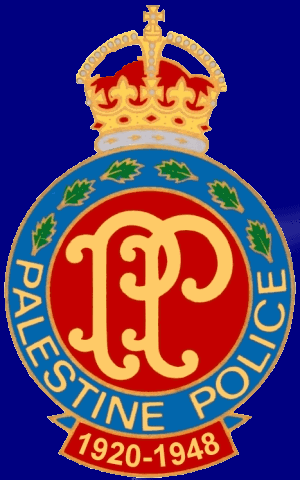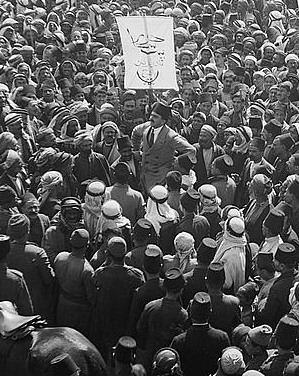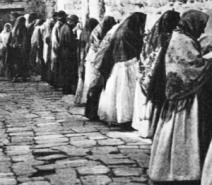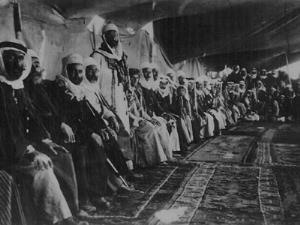Pages in Section 1

The Situation Facing Palestine Police in 1920
i. Formation of the Palestine Police
ii. The Peoples of Palestine in 1920
iii. Early Port Police
iv. Early Clashes
v. Brief Existence of the PDF
vi. Formation of the Palestinian Gendarmerie
vii. Captain James Wesley Mackenzie
viii. 1922 Formation of the British Gendarmerie
vi. Next Section - 1923-1927.
The Arabs
In 1920 the overwhelming majority of the Palestinian population was Arab, mostly Sunni Muslim. However, there was a sizeable Arab Christian population, for the most part 'Greek' Orthodox'. The first British census of Palestine taken on October 23rd 1922 recorded over 200 localities with an Arab Christian population.
 Culturally the most important divisions between Arabs were class, location and education rather than religion. The affluent urban classes, (effendi), and the rural, often illiterate, villagers (fellaheen) had little in common apart from language. Until 1938,male urban merchants, landowners and professionals wore western suits topped by a red Ottoman fez, the fellaheen wore long striped tunics with white keffiyas bound by black agals. Landless labourers in both town and country wore brown skullcaps, baggy black trousers and short tunics. Urban women wore western dress but many kept their faces veiled in public; rural women wore long thobs and head scarves but did not veil their faces; Bedouin, who owned tribal lands but herded their domestic animals across the country often ignoring international borders, kept apart from other Arabs. They wore clothes similar to the fellaheen but generally of better quality.
Culturally the most important divisions between Arabs were class, location and education rather than religion. The affluent urban classes, (effendi), and the rural, often illiterate, villagers (fellaheen) had little in common apart from language. Until 1938,male urban merchants, landowners and professionals wore western suits topped by a red Ottoman fez, the fellaheen wore long striped tunics with white keffiyas bound by black agals. Landless labourers in both town and country wore brown skullcaps, baggy black trousers and short tunics. Urban women wore western dress but many kept their faces veiled in public; rural women wore long thobs and head scarves but did not veil their faces; Bedouin, who owned tribal lands but herded their domestic animals across the country often ignoring international borders, kept apart from other Arabs. They wore clothes similar to the fellaheen but generally of better quality.
The top photo where Arabs of all classes have turned up to a demonstration illustrates the differences in clothing.
The Jews
The Jewish population in Palestine had grown rapidly since the 1870s when Jews had escaped into the Ottoman Empire to escape persecution in Christian Eastern Europe. By 1922 the Jewish population had overtaken that of the Christian Arabs. There were three main types of Jews.
 Sephardim or 'People of the Book,' as they were known by Muslims, for the most part lived in Muslim Mediterranean countries. The Koran contains a mandate to protect the People of the Book. Many Sephardim had lived in Palestine for several centuries, mostly in urban areas, spoke Arabic, dressed like Arabs and were indifferent to Zionism.
Sephardim or 'People of the Book,' as they were known by Muslims, for the most part lived in Muslim Mediterranean countries. The Koran contains a mandate to protect the People of the Book. Many Sephardim had lived in Palestine for several centuries, mostly in urban areas, spoke Arabic, dressed like Arabs and were indifferent to Zionism.
Religious Ashkenazim Jews from Central and Eastern Europe had been around Palestine for centuries, some with lives focussed on religious studies, while others had retired to Palestine to ensure their burial in Jerusalem. These Jews were often supported by funds from abroad. Many religious Ashkenazim were opposed to Zionism.
 The third group of Jews, the Zionists, differed greatly from the other two groups of Jews. They were mainly European Ashkenazim, who had been 'making aliyah', (i.e. returning to the 'Land of Israel') since the third quarter of the 19th century. They had built rural settlements, either kibbutzim (where members owned everything in common) or moshavim (where members had private small holdings but worked collaboratively.) These Zionists aimed to repossess the Land of Israel 'dunum by dunum and goat by goat'.
The third group of Jews, the Zionists, differed greatly from the other two groups of Jews. They were mainly European Ashkenazim, who had been 'making aliyah', (i.e. returning to the 'Land of Israel') since the third quarter of the 19th century. They had built rural settlements, either kibbutzim (where members owned everything in common) or moshavim (where members had private small holdings but worked collaboratively.) These Zionists aimed to repossess the Land of Israel 'dunum by dunum and goat by goat'.
The Armenians
Many persecuted Armenians had fled from Turkey during WW 1 and now lived in Palestinian cities.
The Egyptian Copts
The small number of Egyptian Copts living in urban areas pre-war had been greatly augmented when the British transferred railway workers from Egypt to Haifa
European and Anglo-American Christians
European, Commonwealth and American Christians had been drawn to 'the Holy Land', many as evangelical missionaries, providing schools and hospitals. Two groups, however, the German Templers and the American Colony, had benefited the country without trying to convert others to their own brand of religion. The German Templers, originally agriculturally based, had bred the 'Jaffa Orange' for which the country had become famous and was, in peacetime, the country's main export, while the American Colony improved infant care and provided homes for orphans. Many people in Jerusalem owed their survival during WW 1 to the soup kitchens of the American colony
The Druze
 This monotheistic sect had lived in the Galilee and Carmel area of Palestine for almost a thousand years. They spoke a special dialect of Arabic that sounded much like the Arabic of Syria.
This monotheistic sect had lived in the Galilee and Carmel area of Palestine for almost a thousand years. They spoke a special dialect of Arabic that sounded much like the Arabic of Syria.
The Outlaws
In the early years of the Police Force many Arab and Druze bandits operated in the hilly areas of Palestine,across Galilee, Samaria and Judea and also behind Jaffa and in the Carmel range. The size of their gangs varied from five or six to sixty or more members. These bandits preyed on Arab villages and Jewish settlements. One such gang, its leader wanted for the murder of two Warrant Officers of the Duke of Wellington's Regiment,clashed with Police in the Bab El Wad area. A pursuit by Police lasting almost a week resulted in the arrest of the gang leader who was tried and convicted in Jerusalem.